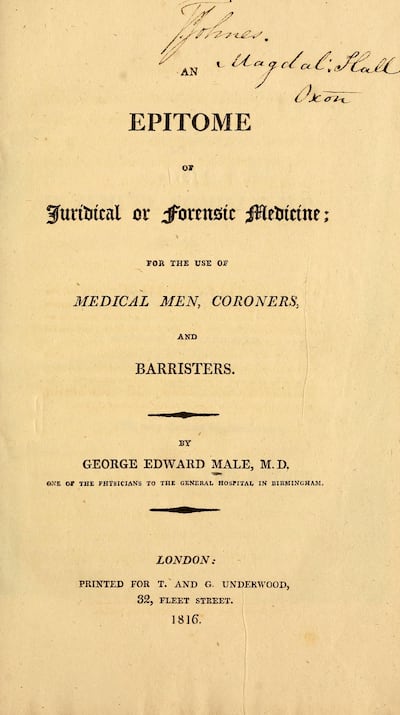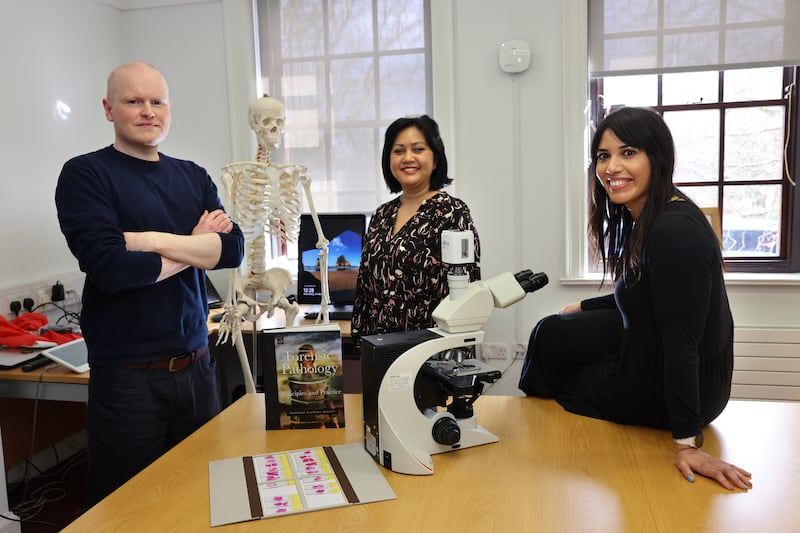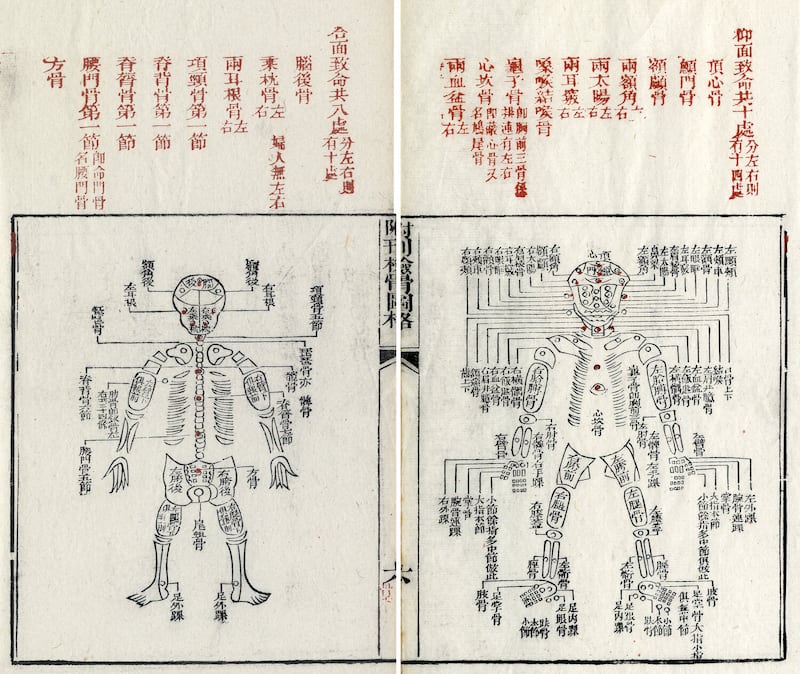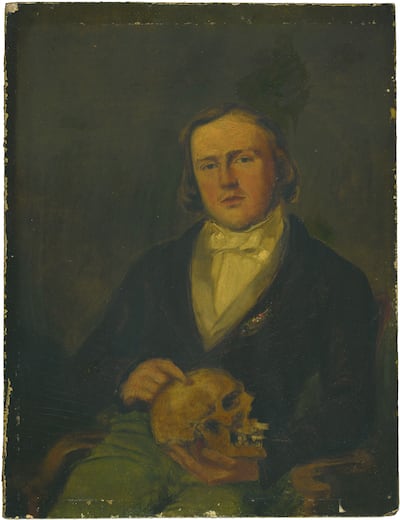To the right listener, the dead can be surprisingly talkative. A pathologist can persuade a corpse to give up many secrets. Books, television dramas, movies and true-crime podcasts have rendered the complex worlds of forensic science and pathology familiar. The journey from crime scene to courtroom is one viewers know well: the arrival of the white-suited pathologist, the fluttering strings of no-entry tape, the grainy CCTV images. Crime drama teaches us to trust forensics, so we nod knowledgably at mentions of mitochondrial DNA, biohazards and blood splatter.
Yet this confidence in forensic science is relatively new. Andrew Hughes, author of The Coroner’s Daughter, says, “In the 19th century there was a lot of scepticism because of blunders that were made in early cases. It was very ego-driven by medical examiners, and often referred to as ‘the beastly science’.” Coroners then didn’t have the medical expertise, or were unwilling to hire a medical expert to look at a body, and juries were reluctant to declare wilful murder, even when it was obvious.
When Abigail Lawless finds herself entangled in the suspicious death of a young nursemaid, she becomes a quick-witted detective, operating at the dawn of forensic science
The Coroner’s Daughter, which is set in 1816, is this year’s One Dublin One Book title, which means the city’s libraries, and its council, are encouraging everybody to read it this month, as a work of fiction with a strong Dublin connection.
It’s a fascinating crime novel in which society expects the well-brought-up Abigail Lawless to be a dutiful daughter or society debutante. Raised among the paraphernalia of her father’s grisly profession, she has other ideas: when she finds herself entangled in the suspicious death of a young nursemaid, she becomes a quick-witted detective, operating at the dawn of forensic science.
Dancing with the Stars: ‘I’ve had the best time of my life. I feel super fit,’ chef Kevin Dundon says as he is voted off show
Oscars 2025 red carpet: Ariana Grande sets the standard while Timothée Chalamet stood out in ‘Kerrygold’ yellow
Róisín Ingle puts a Thermomix to the test: ‘I am a convert but there’s one enormous catch’
“I wanted to write a crime novel set in Regency Dublin with a female protagonist, and since she would need plausible access to cases of murder, the idea of The Coroner’s Daughter popped into my head,” says Hughes.

He had already decided to set the book in 1816, which by happy coincidence was also the year of publication of George Male’s An Epitome of Juridical or Forensic Medicine. Male, a surgeon who had grown increasingly frustrated at the inability of coroners to identify cases of murder because of a lack of medical knowledge, wrote a clear guide outlining the procedures for inspecting a body, the marks associated with violent deaths and scientific tests to establish the presence of poisons. It became Hughes’s textbook for Abigail.
When it comes to sudden, unexplained death with a criminal or suspicious element, the most attentive listeners in the country are to be found in the Office of the State Pathologist. The OSP provides Ireland’s national forensic-pathology service. A rota ensures a forensic pathologist is on call for An Garda Síochána and Ireland’s coroners 24 hours a day, all year round.
At the OSP offices in Dublin, the first thing I notice, apart from how incredibly clean every inch looks, is the strong smell. “That’s the mortuary,” says Dr Heidi Okkers, one of the State pathologists. In the meeting room, rather than the conference-call speaker or water jug you might expect to see on the table, is a skull, carefully annotated with thin reddish lines. Fake, she explains.
Okkers and her colleague Dr Jill Roman, who both studied at Stellenbosch University, in South Africa, have been working in forensic pathology since 2014. Okkers, who has significant experience in trauma and ballistics deaths, was appointed to the OSP in October 2019. When Roman was appointed a Deputy State Pathologist, last December, it meant that all six OSP pathology positions were held by women for the first time.
Despite the huge advances in techniques and technology, Okkers and Roman recognise the methods that Hughes uses in The Coroner’s Daughter. Roman believes Abigail and her father are both ahead of their time in their ability to make investigative leaps and apply empirical methods based on the limited forensic textbooks available at the time. “Dr Lawless has a very good way of interpreting wounds,” she says. “We still use those same signs now.”

One unchanged technique is the way a body is opened; Hughes has his characters employ a method called the Y incision. “With the advancement of technology, many places are moving towards radiological, non-invasive virtual techniques,” says Roman. “But the opening of the body is still the gold standard.”
Roman notes that The Coroner’s Daughter illustrates just how limited forensic investigation once was compared with today’s teams of investigators. “We deal with the body itself and what evidence we can find from the body. We do get called out to scenes as required, and advise and take samples, but there are also forensic investigators at the scene that do the fingerprinting, the mapping, trace-evidence collection. Then you get the laboratory team, who do the DNA analysis of the samples.”
At a public talk, Augustus Granville handed out candles he thought were made from an embalming wax. He had given his guests candles made from decomposed body fat
Where necessary, this wider team can also expand to include a neuropathologist for brain examination, an anthropologist for skeletal remains, an odontologist to look at teeth or bite-mark findings, and an entomologist to examine insect activity, which is useful when there is a question over the time of death.
The origins of forensic science are disputed, though many historians seem to land in China around the sixth century. Using fingerprints as a method of identification has been around since the seventh century. Edmond Locard, the Frenchman behind the phrase “Every contact leaves a trace”, opened the world’s first crime investigation laboratory in 1910. The Scottish crime writer Val McDermid’s nonfiction book Forensics: The Anatomy of Crime, from 2015, quotes a handbook for coroners called The Washing Away of Wrongs. Produced by a Chinese official in 1247, it was still carried to crime scenes by Chinese officials as recently as the last century.

While the earliest known postmortem report is believed to be the autopsy done by Julius Caesar’s private doctor Antistius on his former patient, as far back as 3000 BC the ancient Egyptians were removing and examining human internal organs. The archives of the Royal Society, the British academy of sciences, contain details of an autopsy performed in the 1820s by a doctor named Augustus Granville on an Egyptian mummy. Granville wrote that the bandaging was “most skilfully arranged, and applied with a neatness and precision that would baffle even the imitative power of the most adroit surgeon of the present day”.

In the 1980s, analysis of the hieroglyphs on the coffin lid revealed the woman’s name to be Irtyersenu; her body was carbon-dated to about 600 BC. At a public talk at the Royal Institution, in London, Granville handed out candles made from a waxy substance that he had taken from the mummy. Covering the body in wax was part of the original embalming process, he assumed. Incorrectly, as it turned out, for he had given his guests candles made from decomposed body fat.
In recent years, developments in toxicology and DNA analysis have been revolutionising forensics. Okkers and Roman note how important the advancements in DNA analysis are, because DNA can so clearly connect a perpetrator to a scene. Over the past few years, voluntary DNA submissions to genealogy websites such as Ancestry are contributing to cold cases finally being solved; DNA matching caught the Golden State Killer, one of the United States’ most notorious serial killers. Closer to home, DNA is being tested in relation to the 1984 murder of Baby John, in Co Kerry.
According to the so-called CSI effect, television crime drama has skewed jurors’ expectations of what forensic science can deliver, ultimately affecting their decisions about guilt and innocence. Crime dramas get many things wrong, says Okkers, with establishing a precise time of death being the most consistently erroneous belief. “There is no science to prove it to the exact time – we can only give a range. There are so many variables that you have to consider ... especially with an unwitnessed death where environmental factors also come into play.”
In addition to his forensic research, Hughes read transcripts of coroners’ inquests printed verbatim in 19th-century newspapers. (Clearly, the true-crime fascination is nothing new.) “Each inquest was its own mini drama,” he says, referring to “the description of the victim, particulars of the crime, the testimony of witnesses, often people from the poorest backgrounds whose voices would otherwise have gone unrecorded.”
How society has changed: from women not even being able to question anything to now having in Ireland a pathology department run fully by women
Hughes’s fictional Abigail Lawless was a young woman pushing against the social and scientific constraints of her time. “How society has changed,” says Roman, “from women not even being able to question anything, and murder could be covered up without a proper investigation because of an egotistical, male-dominated system, to now having in Ireland a department run fully by women.”
I like to picture Abigail working in the Office of the State Pathologist. She would be in her element.
In The Anatomy of Crime, a One Dublin One Book event at the Royal Irish Academy, in Dublin, at 7pm on Tuesday, April 4th, Andrew Hughes, Heidi Okkers and Jill Roman will talk about the history of forensic science and its use in fiction, in conversation with the former Irish Times editor Conor Brady. Tickets are free, but booking is essential





















